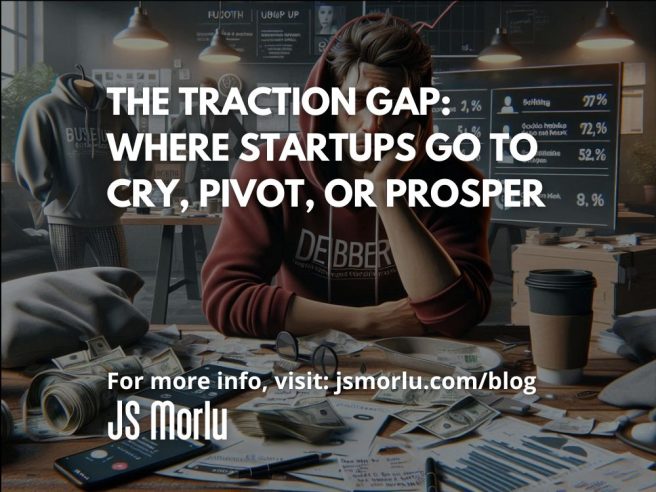By John S. Morlu II, CPA
So you’ve launched a startup. Congratulations! 🎉
Now comes the hard part: the Traction Gap — that awkward phase between “We built it!” and “Wait… why isn’t anyone buying it?”
Think of it like middle school for startups. You’re no longer a baby idea, but you’re also not cool or popular yet. You’re just… there. A little pimply. A little confused. A little desperate.
Fun Fact: 100% of founders believe they’re going to be the next Airbnb.
99% forget that Airbnb almost died three times before getting a single investor.
What Is the Traction Gap?
It’s the chasm between launching your product and proving that people want it, need it, and will pay for it — consistently.
It’s that time when you’ve already spent the money, printed the hoodies, posted the LinkedIn “we’re live” announcement, but you still don’t have a line of paying customers.
It’s where startups die quietly, usually while saying, “We’re still iterating.”
Interesting Tidbit:
The founder of WhatsApp applied for a job at Facebook and got rejected. Then built WhatsApp… and later sold it to Facebook for $19 billion.
Moral of the story: Sometimes the world says “no” so you can say “hell yes.”
Why Is It So Treacherous?
Because everything is working… in theory.
- You have a product.
- You have a pitch deck.
- You might even have users (your mom, your college roommate, and two bots from India).
But no one’s paying. And your team is starting to ask for salaries.
That’s the Traction Gap. It’s like being stuck in an Uber pool with no destination and your investor’s finger hovering over the “stop ride” button.
Brutal Truth:
Investors don’t care that your UI is “clean.”
They care if your revenue is dirty — as in dirty big.
Real Talk: What Actually Happens
Let’s break down the classic signs you’re in the gap:
1. You keep saying “We’re pre-revenue.”
Translation: “We’re broke, but hopeful.”
(And slowly drinking too much coffee.)
2. Your charts are up and to the right… in Google Slides only.
Nobody’s clicking your app. But wow, that mockup is gorgeous.
3. You start calling everything “a test.”
“We’re testing a freemium model.”
“We’re testing silent launches.”
“We’re testing human patience.”
(You’re testing everyone’s faith, too.)
4. You spend more time fixing bugs than talking to customers.
Because it’s easier than rejection.
(But rejection teaches. Silence kills.)
5. You have 1,000 followers but only 3 buyers.
One is your aunt. The other two think you’re a crypto coin.
Startup Math Tip:
Vanity Metrics = 🚽 Toilet Paper.
Use them for comfort. But don’t build a business on them.
Why Most Startups Don’t Survive the Gap
- No clear value proposition
(“We’re like Uber but for pet astrologers.”)
(No one asked for that.) - Too much tech, not enough traction
Engineers keep shipping features, but no one knows what they do.
(Your CTO is building a rocket ship. Your users want a bicycle.) - No sales process
You built it. They didn’t come.
Spoiler alert: They won’t — unless you sell. - Everyone’s too nice
No one wants to say: “This is not working.” So they keep smiling… and burning cash.
(Your burn rate is not a badge of honor. It’s a countdown.)
Honest Observation:
Some founders would rather redesign their logo 10 times than cold-call 10 customers.
How to Cross the Gap Without Falling In
1. Sell. Sell. Sell.
Your job isn’t to build — it’s to prove people will pay.
If you can’t sell it, don’t scale it.
(Selling is not sleazy. Starving is.)
2. Get real users, not just testers.
If people aren’t using your product without you begging them… they don’t need it.
(If they ghost you after the demo, that’s not a lead. That’s a lesson.)
3. Focus on retention, not just downloads.
A million installs mean nothing if 999,000 uninstall after 2 minutes.
(That’s not traction. That’s Tinder.)
4. Listen to customers — not your ego.
“We built this for us” is a great TED talk, but a bad business plan.
(Build for the market. Not your personal brand.)
5. Have a scary honest advisor.
Someone who’ll say, “This sucks — fix it.” Not, “Great job, team!”
(A real mentor pushes your buttons, not your ego.)
Reminder:
Your app is not your baby. It’s a product.
If it’s ugly, say so. Then fix it. Babies get love. Products need value.
Common Sense Corner
- If people don’t understand your website in 5 seconds, they won’t convert.
- If you need a 10-minute explanation, it’s too complicated.
- If you’re solving a problem no one has, you’re the problem.
More Common Sense:
Don’t scale what’s not selling. Don’t automate what’s not proven.
And never confuse effort with effectiveness.
“The Traction Gap is not a tragedy. It’s a test.
Of courage, clarity, and your ability to get someone to give you money on purpose.”
Final Thought
Traction isn’t about hype.
It’s about results.
Crossing the gap means being painfully clear about what you do, who you help, and why they should care.
It’s not glamorous. It’s gritty.
But if you survive the Traction Gap — welcome to the next level.
Just don’t forget:
The gap is always there — just dressed differently.
Bonus Brutal Truth:
Series A is not a trophy. It’s just more pressure — with better coffee.
Warning to All Founders:
If you spend more time perfecting pitch decks than calling leads… you’re not crossing the Traction Gap.
You’re hosting a PowerPoint funeral.
Now go sell something. Or pivot. But don’t pretend.
Because no one claps for “almost.”
Author: John S. Morlu II, CPA is the CEO and Chief Strategist of JS Morlu, leads a globally recognized public accounting and management consultancy firm. Under his visionary leadership, JS Morlu has become a pioneer in developing cutting-edge technologies across B2B, B2C, P2P, and B2G verticals. The firm’s groundbreaking innovations include AI-powered reconciliation software (ReckSoft.com) and advanced cloud accounting solutions (FinovatePro.com), setting new industry standards for efficiency, accuracy, and technological excellence.
JS Morlu LLC is a top-tier accounting firm based in Woodbridge, Virginia, with a team of highly experienced and qualified CPAs and business advisors. We are dedicated to providing comprehensive accounting, tax, and business advisory services to clients throughout the Washington, D.C. Metro Area and the surrounding regions. With over a decade of experience, we have cultivated a deep understanding of our clients’ needs and aspirations. We recognize that our clients seek more than just value-added accounting services; they seek a trusted partner who can guide them towards achieving their business goals and personal financial well-being.
Talk to us || What our clients says about us






